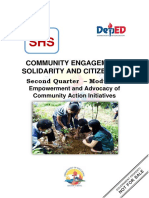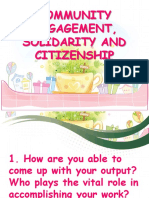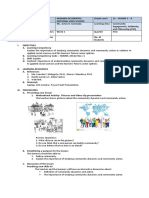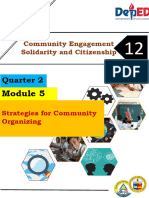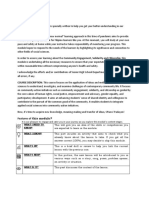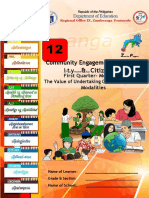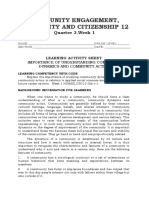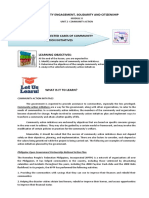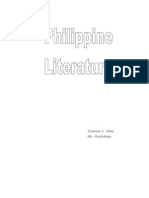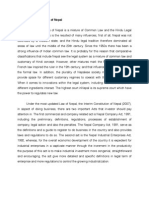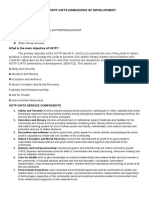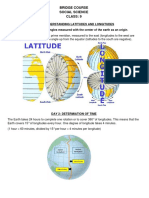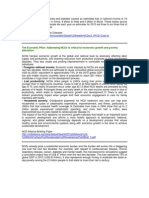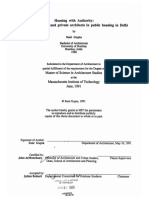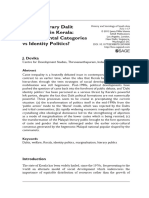SHS
COMMUNITY ENGAGEMENT,
SOLIDARITY AND CITIZENSHIP
Second Quarter – Module 3:
COMMUNITY ACTION INITIATIVES
i
�Community Engagement, Solidarity and Citizenship
Quarter 2 – Module 3: Community Action Initiatives
Republic Act 8293, section 176 states that: No copyright shall subsist in any work of
the Government of the Philippines. However, prior approval of the government
agency or office wherein the work is created shall be necessary for exploitation of
such work for profit. Such agency or office may, among other things, impose as a
condition the payment of royalties.
Borrowed materials (i.e., songs, stories, poems, pictures, photos, brand names,
trademarks, etc.) included in this book are owned by their respective copyright
holders. Every effort has been exerted to locate and seek permission to use these
materials from their respective copyright owners. The publisher and authors do not
represent nor claim ownership over them.
Regional Director: Gilbert T. Sadsad
Assistant Regional Director: Jessie L. Amin
Development Team of the Module
Writer: Cesar D. Herrera Jr.
Evaluator: Arnest D. Dimaano
Editor: Divina M. Diaz, Ph.D.
Ma. Theresa D. Gacosta
Illustrator:
Layout Artist: Edsel D. Doctama
ii
�INTRODUCTION
The government can deliver services more effectively to various sectors in the
country with the help of organizations in the country whose aim is to improve
communities. This module will discuss some of the existing cases of community action
initiatives in the country, focusing on their core values and principles.
OBJECTIVES
In this module, you are expected to assess selected cases of
community action initiatives. Specifically, you should be able to achieve
the following:
1. Identify sample cases of community action initiatives.
2. Determine the objectives of the sample community action initiatives.
3. Assess some selected community action initiatives of different organizations.
Welcome to this module. Here are some of
the major terms which will be used in this entire
module. Read the definitions so that you will be
able to easily understand the discussions per
lesson.
VOCABULARY LIST
Community Action Initiatives - a way for the government, along with other
organizations, to cater to the needs of communities (Semorlan & Semorlan, 2018).
Community Action Agencies (CAA): private nonprofit or public organizations that
were created by federal government in 1964 to combat poverty in geographically
designated areas.
1
� Let’s see how much knowledge you already have on the topic
about community action initiatives. Write your answers on a piece of
paper for submission and checking. Good luck!
PRETEST
1. Which of the following is NOT an example of community action initiative?
a. Philippine Open Government Partnership National Action Plan
b. Community Disaster Intervention Projects
c. Community Action Extension Programs in State Colleges and Universities
d. Immersion of SHS Students with School’s Partner Communities
2. What is the purpose of community action initiatives?
a. To assist community leaders in governing their territory
b. To implement tax avoidance within an organization
c. To cater to the needs of a community
d. To open a community to foreign investors
3. Which of the following is the poverty reduction initiative of the Government of
the Philippines which is being implemented by the Department of Social
Welfare and Development of the Philippines (DSWD0?
a. Kapit-bisig Laban sa Kahirapan-Comprehensive Delivery of Social Services
(KALAHI-CIDSS, or KC)
b. CARE Philippines
c. Pantawid Pamilyang Pilipino Program
d. Philippine Open Government Partnership National Action Plan
2
� 4. Which of the following is a project under ALAY BUHAY Community
Development Foundation, Inc. (ABCDF) which was tailored-fit to respond to the
needs of our partner-communities?
a. Community Empowerment Programme (CEP)
b. Philippine Open Government Partnership National Action Plan
c. Community Disaster Intervention Projects
d. Community Action Extension Programs in State Colleges and Universities
LEARNING ACTIVITIES
SELECTED CASES OF COMMUNITY ACTION INITIATIVES
Community Action Initiatives are a way for the government, along with other
organizations, to cater to the needs of communities. In a community action initiative,
the members of community and organizations become channels for change. People
involved in community action initiatives plan and implement ways to transform a
community and attain a better quality of life (Semorlan & Semorlan, 2018)
The same is existing in the United States of America and are being
implemented by Community Action Agencies. Community Action Agencies (CAA) are
private nonprofit or public organizations that were created by federal government in
1964 to combat poverty in geographically designated areas. Furthermore, in USA, the
status as community action agency is the result of an explicit designation by local or
state government.
(PACECAA (nd). “What is Community Action”. Retrieved from: pacecaa.org on July 4, 2020)
3
�Examples of Community Action Initiatives are the following:
Kapit-bisig Laban sa Kahirapan-Comprehensive Delivery of Social
Services (KALAHI-CIDSS, or KC)
A keystone poverty reduction initiative of the Government of the Philippines is
the Kapit-bisig Laban sa Kahirapan-Comprehensive Delivery of Social Services
(KALAHI-CIDSS, or KC). KC is a CDD program implemented by the Department of
Social Welfare and Development of the Philippines (DSWD). KC targets poor
communities in the country’s 48 poorest provinces (out of 81). In 2011, KC received
US$120 million in funding from the United States government’s Millennium Challenge
Corporation Compact in the Philippines and $59 million in loan funding from the World
Bank. The MCC contracted IPA to carry out an impact evaluation of the program.
This study will evaluate the impact of the KC program on multiple outcomes,
including access to key services; the quantity and quality of participation in local
governance around decision-making and implementation; and knowledge and
awareness of local governance.
The survey sample consists of 198 villages (one randomly selected per
municipality) and 5,940 households (30 randomly selected per village). The 198
municipalities were paired within each province based on similar characteristics (99
pairs) and then randomly assigned through public lotteries to receive the KC program
or serve as a comparison group.
The KC program trains the communities and their local governments, both at
the village and municipal levels, in choosing, designing and implementing public
projects called “subprojects”. This is done through a five-stage program known as the
KC Community Empowerment Activity Cycle (CEAC). Roughly one-third of villages
4
�receive subprojects each year, although some villages may receive multiple
subprojects and others none over the course of the project. Most subprojects are
programmed to be implemented within six months, thus the stages of preparation,
funding and implementation generally take nine to twelve months and are called a
cycle. The same process is repeated over three one-year cycles, with cycles two and
three having a condensed CEAC phase since communities have already become
familiar with the project and process.
Data for the estimate of outcomes and impacts of KC will come from multiple
rounds of data collection exercises, each involving several instruments including a
household survey, village survey, a Structured Community Activity, qualitative focus
groups, and qualitative key informant interviews. Each round of data collection will be
implemented by Philippines-based survey firms and overseen by the Millennium
Challenge Account-Philippines and IPA.
Community Empowerment Programme (CEP) - ALAY BUHAY Community
Development Foundation, Inc. (ABCDF)
Community Empowerment Programme (CEP) was tailored-fit to respond to the
needs of our partner-communities. The CEP utilized a participative process from
community organizing, people’s empowerment, planning, implementation, monitoring
and evaluation, and most importantly, decision-making. In the process, members
learned to take greater responsibility for the future of their communities.
Through the cooperatives/people’s organization and microfinance centers
formed based on common issues/interests, the communities respond continuously to
their livelihood, education and health concerns. Aside from providing income, the
community enterprises established during the program are mostly food-based which
5
�considered the nutritional needs of the community members especially children, about
35% are malnourished. Moreover, various community activities on livelihood, health,
education, environment, safety and disaster response were undertaken. Partnerships
were built and networks were established with local government units, government
institutions, religious institutions, public health and medical professionals, and NGOs
for development collaboration and resource mobilization.
CARE Philippines
CARE plays three roles for impacting on poverty and social injustice in our
efforts to achieve lasting impact at scale and promote inclusive development. Working
with our partners, we use effective models and approaches to support the most
marginalized communities to overcome poverty, social injustice and humanitarian
crises. We then use and apply the evidence and learning of our programs to influence
broader change and to scale up effective solutions:
1. Humanitarian action. In emergencies, we respond to save lives, with special
attention to the needs of women and girls and the most marginalized. Our
humanitarian action includes preparedness and early action, emergency
response and recovery, and encourages future resilience and equitable
development.
2. Promoting lasting change and innovative solutions. CARE and our
partners trigger innovative solutions for sustainable development through
supporting new ways of supplying or strengthening essential service delivery,
building capacities, building resilience for reducing risk, and empowering the
most vulnerable, particularly women and girls. They are based on a deep,
historical understanding of the drivers of poverty and social injustice in a
particular context and tailored to the needs of the most marginalized. We have
6
� a special focus in the areas of rights to sexual and reproductive health; to a life
free of violence; to food and nutrition security; and women’s economic
empowerment. The evidence and learning from these programs is essential
for our third role, which amplifies our impact.
3. Multiplying impact. All our work seeks to impact in and beyond the
communities in which we directly work. Together with our partners we use
evidence, learning and innovation from our humanitarian action and long-term
development programs to influence broader social change, at significant scale.
It is through this role that CARE can contribute to deeper and sustainable
impact by documenting successful models, leveraging knowledge, advocating
for replication and expansion of proven approaches, promoting pro-poor
solutions, influencing power holders at all levels to change their policies and
practices, and convening and brokering linkages between actors.
ATD Fourth World Philippines: All Together in Dignity to Overcome
Poverty Building Knowledge and Accessing Education – Every Mind
Counts
“Education for All” Many people living in extreme poverty and exclusion are
prevented from expressing their experiences. They cannot contribute to projects that
affect them. Neglecting and ignoring the intelligence of people living in poverty — men,
women, young people, and children – are discriminatory acts against society.
Shaping a people-centered and earth-friendly economic vision
“People-centered Economy” The present global economic systems create a
permanent state of crisis for people in extreme poverty – a daily struggle to create a
livable but unsustainable and inhumane environment. They try to survive with the
7
�barest necessities be it with or without a regular job and income. We (with partner
organizations and individuals) are engaged in exploring alternative economic models
as means of providing people a livelihood. This may involve training, workshops, and
providing links with organizations that can provide them with jobs and training. Our
aim is to foster the well-being of people and communities, especially the most
disadvantaged ones.
Organizing for Human Rights and Peace
“A Voice against Poverty” It is essential to speak out on the violence of poverty
since human rights are violated. Communications is important to create awareness
of the daily struggles of people in poverty and exclusion. By being their voice, we are
contributing towards building peace by engaging people in society to be our partners
in ending extreme poverty. In the past years, we have launched social media
campaigns of our different programs, conducted workshops in Communications,
invited print and broadcast media to our activities, and engage institutions and
schools in public meetings.
Sources:
Community Toolbox (nd). “Community Empowerment Programme (CEP) - ALAY
BUHAY Community Development Foundation, Inc. (ABCDF) – Manilla, Philippines.”
Retrieved from: ctb.ku.edu on July 11, 2020.
CARE Philippines: International Humanitarian Organization (nd). “What We Do”
Retrieved from: care-philippines.org on July 4, 2020.
ATD Fourth World Philippines (nd). Community Projects. Retrieved from atpdph.org on
July 4, 2020.
Do you want to read more articles about community action initiatives in the Philippines? You
can read more on the links provided for you below:
https://news.abs-cbn.com/news/12/17/19/psychosocial-debriefing-lugaw-hatid-sa-mga-
nalindol-sa-davao-del-sur
https://www.manilatimes.net/2020/03/29/weekly/the-sunday-times/filipino-
champions/digital-giving-platform-mounts-combat-covid-for-good/707600/
https://globalnation.inquirer.net/80167/greenpeace-to-help-reef-check-at-apo-marine-
sanctuary
8
� How was the learning activities?
Since you are now equipped with the
necessary knowledge on the topic, you
are now ready for practice tasks. Good
luck!
Practice Task 1: Kusina ng Kalinga
Direction: Read the article and answer the questions below.
The “Kusina ng Kalinga” project of Gawad Kalinga (GK) is an example of an
existing Community Action Initiative in the Philippines.
In a survey conducted in 6 schools in Norzagaray, Bulacan, the malnutrition
rate is pegged at an alarming rate of 14%. The national figures even offered a more
grim image: according to the Food and Nutrition Research Institute (FNRI) in 2013,
20% of preschool-aged children in the Philippines are underweight, while 30.3% are
stunted.
With this figures, how can advocates start the fight against hunger in
schools?
This is the question that Gawad Kalinga’s (GK) “Kusina ng Kalinga” project aims
to address. Specifically, the goal of the project is to nourish elementary public school
students in Norzagaray, Bulacan by providing them nutritious in-school lunch meals
to be distributed to 4 beneficiary schools for 120 days.
“Hunger plays a key role in making our students stay in school. Most drop-outs
are [caused by] hunger. At first level, we are addressing that with this partnership,
but at a more macro and lasting one, we are actually addressing education itself,"
Gawad Kalinga executive director Jose Luis Oquiñena said.
9
� According to GK, at least 1,500 public school children are going to benefit
from this project, with student recipients ranging from kindergarten to Grade 3. The
program is targeting the age gap of children most vulnerable to malnutrition.
(READ: Why are feeding programs important in the fight vs hunger?)
"It’s not just about every meal we give to the children, it’s an opportunity for
these children to be on the platform for education," Oquiñena added.
(Source: Jocson, Luisa. “How groups are bringing the fight against hunger to schools”.
Retrieved from: https://www.rappler.com/move-ph Accessed on July 4, 2020)
Guide Questions:
1. What is/are the objective/s of Gawad Kalinga’s (GK) “Kusina ng Kalinga”
project?
2. How does GK’s Kusina ng Kalinga project help the community in the long
run?
3. Do you think Gawad Kalinga’s (GK) “Kusina ng Kalinga” project can really
be classified as a community action initiative? Why?
4. With Gawad Kalinga’s (GK) “Kusina ng Kalinga” project as basis, what is a
Community Action Initiative?
Practice Task 2
Direction: Read the excerpt below. Afterwards, answer the questions that follow.
Community action includes a broad range of activities and is sometimes
described as ‘social action' or ‘community engagement'. These activities can vary in
their objective, the role the community plays, the types of activities involved, their scale
and their integration within the council. What they have in common is that they all
involve greater engagement of local citizens in the planning, design and delivery of
local services.
10
�Moreover, community action is about putting communities at the heart of their own
local services. Involving communities in the design and delivery of services can help
to achieve a number of objectives, that include building community and social capacity
by helping the community to share knowledge, skills and ideas. Community resilience
by helping the community to support itself. Prevention by focusing on early access to
services or support, engagement in design, cross-sector collaboration and
partnerships.
Maintaining and creating wealth, for example help people into employment or
develop community enterprises.
The role the community plays may include community consultation, joint
planning, joint design, joint delivery and community-led activities. The types of activity
can include the following: asset transfer (either through formal transfer to bodies such
as parish councils or community interest companies, or transfer of their management
to local community and voluntary groups); making better use of physical resources,
such as council-owned buildings to support community-led activities; community
engagement in decision-making (for example through public engagement events
where the community helps to decide local priorities, co-design or co-commission
services); community networks; and community grants.
Source: Local Government Action (2020). “What is Community Action?” Retrieved from:
https://www.local.gov.uk on July 4, 2020.
Guide Questions:
1. Why is the conduct of community action initiative beneficial to the government
of a particular state?
11
� 2. What benefits can a community get from community action initiatives being
implemented by various government and non-government/non – profit
organizations?
3. How can a community help in maximizing the benefits they are receiving from
the implementers of community action initiatives?
Practical Task 3
Assess the community action initiatives of different organizations as discussed
in this module. Use the table below in doing your assessment.
Program Issues Benefits Possible
Addressed Outcomes
Community
Empowerment
Programme (CEP)
- ALAY BUHAY
Community
Development
Foundation, Inc.
(ABCDF)
CARE Philippines
ATD Fourth World
Philippines: All
Together in Dignity
to Overcome
Poverty
12
� Congratulations for
making this far. I know you have
learned a lot about Selected
Cases of Community Action
Initiatives. You have done great!
POST TEST
Mention two Community Action Programs in the Philippines. Discuss them briefly, and
reflect on the importance of both programs. Reflection should not be more than 5
sentences. Score will be rated using the rubric below.
PROGRAM 1
Name of Program:
Objective/s:
Reflections on the
Program
PROGRAM 2
Name of Program:
Objective/s:
Reflections on the
Program
13
� RUBRIC FOR REFLECTION
EARNED
CRITERIA 10 points 6 points 3 points 1 point
POINTS
Content Substantial, Sufficiently Limited Superficial
specific and developed content with and/or
demonstrating content with inadequate minimal
development adequate elaboration content
of elaboration or
sophisticated or explanation
ideas explanation
Sentence At most 10 Exceeds to Exceeds to Exceeds to
Count
sentences 1 sentences 2 sentences 3 or more
sentences
Spelling All spelling 1 to 2 errors 3 to 5 errors At least 6
and
and grammar errors
Grammar
are correct committed
Focus Sharp and Apparent No Minimal
pointed out point made apparent relation to
clearly ideas point but the topic
still related
to the topic
ASSIGNMENT
Think of a community action initiative implemented or being implemented in
your barangay and assess it using the table in Practical Task 3.
CONGRATULATIONS!
You made it!
14
�Answer Key
PRETEST
1. D
2. D
3. A
4. A
PRACTICE TASKS 1,2,3
- Answers may vary
15
�REFERENCES
Jocson, Luisa. “How groups are bringing the fight against hunger to schools”.
Retrieved from: https://www.rappler.com/move-ph on July 4, 2020.
PACECAA (nd). “What is Community Action”. Retrieved from: pacecaa.org on July 4,
2020.
Community Toolbox (nd). “Community Empowerment Programme (CEP) - ALAY
BUHAY Community Development Foundation, Inc. (ABCDF) – Manilla, Philippines.”
Retrieved from: ctb.ku.edu on July 11, 2020.
CARE Philippines: International Humanitarian Organization (nd). “What We Do”
Retrieved from: care-philippines.org on July 4, 2020.
ATD Fourth World Philippines (nd). Community Projects. Retrieved from atpdph.org
on July 4, 2020.
Local Government Action (2020). “What is Community Action?” Retrieved from:
https://www.local.gov.uk on July 4, 2020.
Semorlan, Ava Ann P. & Adrian P. Semorlan (2018). Community Engagement,
Solidarity, and Citizenship. C & E Publishing: Quezon City.
Cover photo credit: Melody D. Legaspi (Rizal Integrated National School, Sorsogon City)
16






